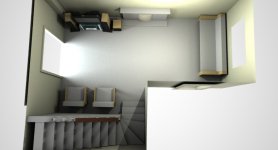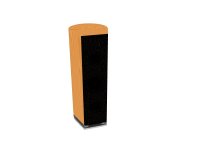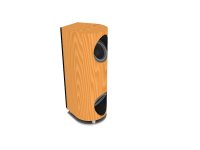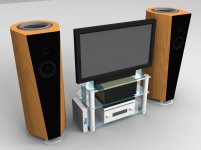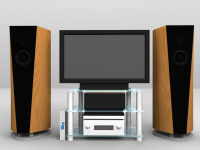Hi All,
First diy design is ongoing. It's on paper atm (and in 3D) but it's just the visuals; no measurements/projections attached to it yet as I simply lack that experience/knowledge right now.
What I'm looking for some fronts to satisfy the following requirements:
Because I've spent the last two years drooling over the 802Ds, I'm thinking of taking my inspiration from them; dual woofers (perhaps 8" or 10", balanced by the xo), mid in its own chamber, tweeter up top.
To this end, I have a few questions:
Most of these questions are born from my lack of listening experience with hifi systems. I have the B&W 683s right now and they sound good to me but I really want more than what I've got. I want better clarity in both my highs and lows, wider sound stage, better transparency, etc. I want speakers that would cost me a bajillion pounds, commercially, for about a tenner. 😉
Cheers,
Dave.
First diy design is ongoing. It's on paper atm (and in 3D) but it's just the visuals; no measurements/projections attached to it yet as I simply lack that experience/knowledge right now.
What I'm looking for some fronts to satisfy the following requirements:
- Ultra clear highs+mids; warm, bass.
- Music tastes: I like everything 'cept country; cuz country ain't music. However, most of my listening is, atm, new age... though I go through phases where I like classical, rock, rap, etc. I'd rather have accuracy over boom though.
- Good power handling; I'd like them to shake the house with HT too.
- Room sizes will generally be wide but not very deep (usually 8-10' from listening position and 20' wide; see attachment to see my current flat)
- Budget? Unknown. I'll start with a budget of 2500 pounds for drivers+electronics with the expectation that nothing ever comes in on budget, so closer to 4000 (in stages). I'm toying with getting some diamond tweeters in parts, but honestly, the more I save on the speakers, the more I'm allowed to spend on the amp.
- It cannot have 6 sides; I hate boxes and so does the wife. I'm thinking of a curved back enclosure or other variety.
Because I've spent the last two years drooling over the 802Ds, I'm thinking of taking my inspiration from them; dual woofers (perhaps 8" or 10", balanced by the xo), mid in its own chamber, tweeter up top.
To this end, I have a few questions:
- What plays the biggest role in providing transparency to a loudspeaker? Cabinet shape? Driver quality? Volume of the the cabinet? Magic? Marketing?
- Does the shape of the enclosure affect the overall precision of the sound? ie - I've already been told that spherical and cylindrical enclosures offer the best sound for bass which leads me to think that this is because those shapes offer relatively uniform resistance under compression from the driver. (So I'm surprised that 99% of cabinets out there are boxes; especially in high end ones).
- (Assuming MDF construction) Does having the mids/highs in the same enclosure as the bass greatly effect their sound? What if they're in their own closed chamber in the same enclosure?
- Is there significant merit to completely segregating the highs/mids from the bass enclosure (and possibly even each other)?
- When you get to the higher end for woofers, does it really make a difference as to which one you buy (ignoring the cabinet requirements)?
Most of these questions are born from my lack of listening experience with hifi systems. I have the B&W 683s right now and they sound good to me but I really want more than what I've got. I want better clarity in both my highs and lows, wider sound stage, better transparency, etc. I want speakers that would cost me a bajillion pounds, commercially, for about a tenner. 😉
Cheers,
Dave.
Attachments
1: driver selection, followed by box design and crossover design
2: depending on what you mean by 'precision', yes. Cylinders and spheres have advantages, but they also have pitfalls - what is good for outside the box can be the opposite on the inside.
3 & 4: Yes, generally mids should be in their own sealed enclosure to isolate them from the backwave of the woofer. Don't assume MDF construction.
5: Depends on where you cross over to the mid, but generally I'd say no -- others will probably disagree. Spend more money on good mids.
2: depending on what you mean by 'precision', yes. Cylinders and spheres have advantages, but they also have pitfalls - what is good for outside the box can be the opposite on the inside.
3 & 4: Yes, generally mids should be in their own sealed enclosure to isolate them from the backwave of the woofer. Don't assume MDF construction.
5: Depends on where you cross over to the mid, but generally I'd say no -- others will probably disagree. Spend more money on good mids.
@PeteMck, thanks; could I ask you to clarify some points?
1: Transparency
a. re: Driver Selection - most important for transparency is the tweeter or the mid or, IYO, both play an equal role?
b. Box design - proper balance of internal volumes? internal chamber shape? external shape?
ie - obviously, the speaker shouldn't be inside of a tunnel (ie - recessed into the enclosure), but anything else?
2: By precision I meant that I'm more concerned with sound accuracy than SPL.
5: Spend more on good mids - awesome, thanks!
1: Transparency
a. re: Driver Selection - most important for transparency is the tweeter or the mid or, IYO, both play an equal role?
b. Box design - proper balance of internal volumes? internal chamber shape? external shape?
ie - obviously, the speaker shouldn't be inside of a tunnel (ie - recessed into the enclosure), but anything else?
2: By precision I meant that I'm more concerned with sound accuracy than SPL.
5: Spend more on good mids - awesome, thanks!
note: it might also help to know where I'm coming from with these questions. Attached are some enclosure designs that I'm toying with.
I've discarded the read-diagonal woofer idea (while it looks awesome, it's really impractical so I might go for a horizontal rear mount instead but with a round enclosure, that means they'd be recessed into a cutout of the enclosure or mounted on a tube that protrudes out; also not ideal)
The third attachment, speaker2.png, is more where I'm heading. Vertically aligned drivers, mounted at the end of a cylinder (that floats in the overall enclosure on silicone lining; a design I came up with as a result of my "zero-vibration subwoofer question/thread). This frees up the front of the speaker for just the one tweeter and mid on the front.
These kinds of designs have spousal approval (though, she says, it's a bit big) but, aside from the fact that manufacturing it would be a nightmare, I'm not sure where this design (or any like it) falls down.
Note; The second pair of images show the size of the enclosure with 2x 12" subs (vertically mounted, firing opposite each other). I may shrink the overall enclosure by 15% and mount 2x10" subs... if I even stick with this overall theme.
I've discarded the read-diagonal woofer idea (while it looks awesome, it's really impractical so I might go for a horizontal rear mount instead but with a round enclosure, that means they'd be recessed into a cutout of the enclosure or mounted on a tube that protrudes out; also not ideal)
The third attachment, speaker2.png, is more where I'm heading. Vertically aligned drivers, mounted at the end of a cylinder (that floats in the overall enclosure on silicone lining; a design I came up with as a result of my "zero-vibration subwoofer question/thread). This frees up the front of the speaker for just the one tweeter and mid on the front.
These kinds of designs have spousal approval (though, she says, it's a bit big) but, aside from the fact that manufacturing it would be a nightmare, I'm not sure where this design (or any like it) falls down.
Note; The second pair of images show the size of the enclosure with 2x 12" subs (vertically mounted, firing opposite each other). I may shrink the overall enclosure by 15% and mount 2x10" subs... if I even stick with this overall theme.
Attachments
Last edited:
note: The technicians out there will say that this doesn't classify as a design yet because I haven't given any specifics on dimensions, volume, drivers, etc.
But at this stage, I'm only concerned with whether the overall direction that I'm taking with the enclosure is going to be bad for the clarity & transparency of my sound.
After all, if I put all of the work into these enclosures, I don't want a design flaw to make them sound like mud.
But at this stage, I'm only concerned with whether the overall direction that I'm taking with the enclosure is going to be bad for the clarity & transparency of my sound.
After all, if I put all of the work into these enclosures, I don't want a design flaw to make them sound like mud.
Driver selection - the mid is by far the most important; if you can get the distortion profile if the driver it will help with selection. This is not published by manufacturers, google Zaph Audio for tests.
Box design - I prefer a semi-circular enclosure behind the mids, but the shape isn't the important thing, it's the damping of the panel resonances and internal standing waves. Obviously shape can help with this. Check out Troels Gravesen's site for plenty of interesting constructions
Box design - I prefer a semi-circular enclosure behind the mids, but the shape isn't the important thing, it's the damping of the panel resonances and internal standing waves. Obviously shape can help with this. Check out Troels Gravesen's site for plenty of interesting constructions
@PeteMck - thanks for the links; I've spent about 2 mins on Troels site and it's knocked my socks off!
1. The crossover is the single most important part of the speaker. Everything else is secondary.
Any monkey can pick some cool looking drivers, build a really awesome looking box, and buy a ready made Xover, but it will most likely sound like crap. The Xover Is the speaker.
Any monkey can pick some cool looking drivers, build a really awesome looking box, and buy a ready made Xover, but it will most likely sound like crap. The Xover Is the speaker.
1. The crossover is the single most important part of the speaker. Everything else is secondary.
In a sense. Everything is important.
Crossovers are evil. It is certainly the hardest to get to work decently. I avoid them completely as much as possible, and if i have to use one, put it where it is less an issue (really low or really high)
dave
...
I want better clarity in both my highs and lows, wider sound stage, better transparency, etc. I want speakers that would cost me a bajillion pounds, commercially, for about a tenner. 😉
...
At least you know, what you want. 😀
Maybe you heard about the TEMPTATION FROM THE DARK SIDE ? 😎
Thought about leaving the cabinet behind and build dipoles or hybrids ?
But anyhow, the position of the speakers shown in the room is not suited
for dipoles. It it is very problematic for any speaker i would guess.
What about throw..nghpmp.. hanging the screen over the door and placing
the speakers left and right from the door ?
Listening position could be in the direction where the sofa is right now,
but slightly forward.
Like positioned now, you cannot find any speaker in the world which performs
there as my educated guess.
Kind Regards
Last edited:
I have several concerns and I agree with LineArray.
First you are planning a very ambitious first DIY build. That is a lot of cash to and effort in an attempt to do, in one shot, what many skilled people have been working on for years. What you want takes experience, some trial and error, or someone elses design, but then you still will have to hope that meets your expectations, which, I might add, are large.
Next, you plan to put said excellent and expensive speakers in a room that is not only very tough to deal with by itself, but located in an area that will suck much of what you want out of the speakers. You will have lopsided reflections form one speaker in a corner and the other along a long wall, the doorway will suck bass away and there will likely be some disturbing resonant frequencies from the large open space to listener's right. The irregular wall with stairs might be ok.
You might be better off moving the system to the wall with the couch and putting the couch near the foot of the stairs. Simple treatments to the side walls and perhaps a trap in the corner to the right of the doorway may be all that is needed to make it workable, if you put the listening position (couch or chairs) in the right place, not too far back.
The room may be more important than the nuances of the super high end speaker project, even if you get it right. You may be able to cut the cost of the speakers in half and use the rest to treat and arrange the room.
First you are planning a very ambitious first DIY build. That is a lot of cash to and effort in an attempt to do, in one shot, what many skilled people have been working on for years. What you want takes experience, some trial and error, or someone elses design, but then you still will have to hope that meets your expectations, which, I might add, are large.
Next, you plan to put said excellent and expensive speakers in a room that is not only very tough to deal with by itself, but located in an area that will suck much of what you want out of the speakers. You will have lopsided reflections form one speaker in a corner and the other along a long wall, the doorway will suck bass away and there will likely be some disturbing resonant frequencies from the large open space to listener's right. The irregular wall with stairs might be ok.
You might be better off moving the system to the wall with the couch and putting the couch near the foot of the stairs. Simple treatments to the side walls and perhaps a trap in the corner to the right of the doorway may be all that is needed to make it workable, if you put the listening position (couch or chairs) in the right place, not too far back.
The room may be more important than the nuances of the super high end speaker project, even if you get it right. You may be able to cut the cost of the speakers in half and use the rest to treat and arrange the room.
Hi,
If you think you can design something better than 802D's your kidding yourself.
Troels site is a good place for the really serious designs, use one if you insist.
Its far easier to get it wrong than it is to get it right, and for you expensive.
😎/Sreten.
If you think you can design something better than 802D's your kidding yourself.
Troels site is a good place for the really serious designs, use one if you insist.
Its far easier to get it wrong than it is to get it right, and for you expensive.
😎/Sreten.
I would say look at some of "ShinOBIWAN" past projects, but many of the best photos have disappeared. This is a link to one project:
http://www.diyaudio.com/forums/multi-way/93218-lgt-construction-diary.html
http://www.diyaudio.com/forums/multi-way/93218-lgt-construction-diary.html
Go active. Check out Rod Elliott's web site.
Hi,
Or do not, he's fairly clueless when it comes to loudspeaker design.
As I said "Its far easier to get it wrong than it is to get it right".
Checkout Siegfried Linkwitz's site for the dirty on active speakers.
😎 /Sreten.
Last edited:
sreten,
As for this;
Dave,
It isn't easy to build a good speaker but it isn't as hard as some make it out to be either. The steps are;
Decide how many ways (I suggest three way or four way)
Select the best (read, expensive with flat responses) drivers for the intended frequency ranges (Elliott and Lenardaudio.com cover this well)
Design a crossover - this can be hard, if passive, or consider active which makes it a lot easier
Select crossover points outside the critical ranges for human hearing
Build boxes
Bulid crossovers
Assemble
Test.
I built three way actives against the advice of some on this forum and are very happy with the sound. I wanted clarity and accuracy and now have it. The downside is that some CDs now sound rubbish but it is because there weren't produced well but I hear what is on the CD, not what I think I want to hear.
My crossover points are 300 and 3,000 Hz and I use Rod Elliott's printed circuit boards for all of the active crossovers and amps. (No, I don't work for Rod or even know him. His stuff does work though.)
These links may help;
http://www.lenardaudio.com/main/04_sarabande.html
http://www.lenardaudio.com/education/01_eduintro.html
http://sound.westhost.com/bi-amp.htm
http://sound.westhost.com/bi-amp2.htm
http://sound.westhost.com/biamp-vs-passive.htm
http://sound.westhost.com/sp-boxes.htm
http://sound.westhost.com/sp-boxes2.htm
Frank
I hadn't expected this level of blatant rudeness from you but I live and learn. At least Rod has posted a speaker build of his own on his website.Or do not, he's fairly clueless when it comes to loudspeaker design.
As for this;
People such as Linkwitz and John Burnett design active speakers because they work well and can be demonstrated as such (and sell).Crossovers are evil. It is certainly the hardest to get to work decently. I avoid them completely as much as possible, and if i have to use one, put it where it is less an issue (really low or really high)
Dave,
It isn't easy to build a good speaker but it isn't as hard as some make it out to be either. The steps are;
Decide how many ways (I suggest three way or four way)
Select the best (read, expensive with flat responses) drivers for the intended frequency ranges (Elliott and Lenardaudio.com cover this well)
Design a crossover - this can be hard, if passive, or consider active which makes it a lot easier
Select crossover points outside the critical ranges for human hearing
Build boxes
Bulid crossovers
Assemble
Test.
I built three way actives against the advice of some on this forum and are very happy with the sound. I wanted clarity and accuracy and now have it. The downside is that some CDs now sound rubbish but it is because there weren't produced well but I hear what is on the CD, not what I think I want to hear.
My crossover points are 300 and 3,000 Hz and I use Rod Elliott's printed circuit boards for all of the active crossovers and amps. (No, I don't work for Rod or even know him. His stuff does work though.)
These links may help;
http://www.lenardaudio.com/main/04_sarabande.html
http://www.lenardaudio.com/education/01_eduintro.html
http://sound.westhost.com/bi-amp.htm
http://sound.westhost.com/bi-amp2.htm
http://sound.westhost.com/biamp-vs-passive.htm
http://sound.westhost.com/sp-boxes.htm
http://sound.westhost.com/sp-boxes2.htm
Frank
Last edited:
.......You will have lopsided reflections form one speaker in a corner and the other along a long wall, the doorway will suck bass away and there will likely be some disturbing resonant frequencies from the large open space......
I wish my listening room was ^THAT^ good........😱
Mick.
Select crossover points outside the critical ranges for human hearing... My crossover points are 300 and 3,000 Hz
Note that 3kHz is right in the area where the ear is most sensitive.
If you want to keep XO out of critical range, no XO points between 400-5k.
With some of the newest FR drivers it is possible to do a 2-way with an XO 100-400 Hz that really makes one ask why bother with 3-way (especially if a dome tweeter is involved)
You will get lots of opinions. That is because even the best speakers are a shadow of where they will be someday (i'd guess 10-20%). Because of this it is possible to have 2 completely different speakers that are equally valid. You need to pick the compromises best suited to your needs.
To this end, as been at least hinted at earlier in the thread, i'd suggest a more modest 1st project . To gain some experience. And to get some perspective on the best set of compromises for you.
dave
PS: the local dealer sells B&W (actually has since i worked there 30 years ago). Althou full of some really good & innovative design, the 802s don't rock my boat.
Dave,
As you are discovering, speaker building is all about compromise; the extent to which you do that depends on the $$$$$ you want to commit. Even opinion of the most critical range of hearing differs.
Why Do Frequency Response Curves Matter?
Frank
As you are discovering, speaker building is all about compromise; the extent to which you do that depends on the $$$$$ you want to commit. Even opinion of the most critical range of hearing differs.
Why Do Frequency Response Curves Matter?
Frank
A good primer on reading FR graphs, but mostly about microphones.
dave
- Status
- Not open for further replies.
- Home
- Loudspeakers
- Multi-Way
- Rules of Thumb for Enclosure Designs - Questions
